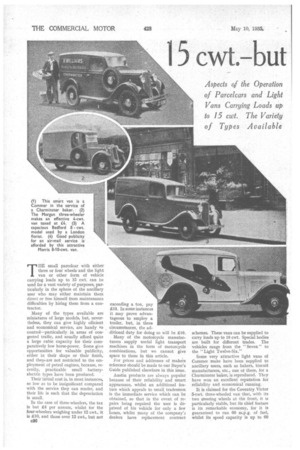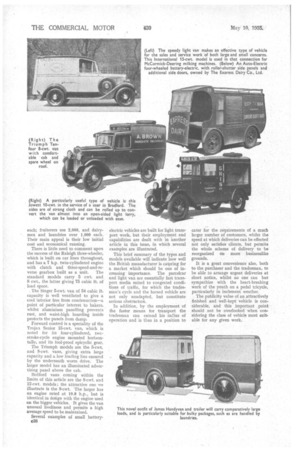cwt.-but no more 0
Page 94

Page 95

Page 96

If you've noticed an error in this article please click here to report it so we can fix it.
THE small parcelcar with either three or four wheels and the light van or other form of vehicle carrying loads up to 15 cwt. can be used for a vast variety of purposes, particularly in the sphere of the ancillary user who may either maintain them direct or free himself from maintenance difficulties by hiring them from a contractor.
Many of the types available are miniatures of large models, but, nevertheless, they can give highly efficient and economical service, are handy to control—particularly in areas of congested traffic, and usually afford quite a large cubic capacity for their comparatively low horse-power. Some give opportunities for valuable publicity, either in their shape or their finish, and they. are not restricted to the employment of petrol engines, because, recently, practicable small batteryelectric types have been produced.
Their initial cost is, in most instances, so low as to be insignificant compared with the service they can render, and their life is such that the depreciation is small.
In the case of three-wheelers, the tax is but £4 per annum, whilst for the four-wheelers weighing under 12 cwt., it is £10, and those over 12 cwt., but not c.86
exceeding a ton, pay £15. In some instances it may prove advantageous to employ a trailer, but, in these circumstances, the additional duty for doing so will be £10.
Many of the motorcycle manufacturers supply useful light transport machines in the form of motorcycle combinations, but we cannot give space to these in this article. For prices and addresses of makers reference should be made to our Buyer's Guide published elsewhere in this issue.
Austin products are always popular because of their reliability and smart appearance, whilst an additional feature which appeals to small tradesmen is the immediate service which can be obtained, so that in the event of repairs being required the user is deprived of his vehicle for only a few hours, whilst many of the company's dealers have replacement contract schemes. These vans can be supplied to carry loads up to 10 cwt. Special bodies are built for different trades. The vehicles range from the " Seven " to the "Light Twelve-Six." Some very attractive light vans of Commer make have been supplied to ancillary users, such as bakers, biscuit manufacturers, etc., one of these, for a Charminster baker, is reproduced. They have won an excellent reputation for reliability and economical running.
It is claimed for the Coventry. Victor 5-cwt. three-wheeled van that, with its two steering wheels at the front, it is particularly stable, but its chief feature is its remarkable economy, for it is guaranteed to run 60 m.p.g. of fuel, whilst its speed capacity is up to 60
m.p.h., with markedly good acceleration, An unusual feature is that the twin-cylindered engine is water-cooled, anda three-speed-and-reverse gearbox is provided. Vans of this make have been supplied to bakers, butchers, poultry dealers, milkmen, dyers and cleaners, laundries, florists and for parcel-delivery services.
Three-wheelers of 3-5 cwt. and 7-10 cwt. are built in the Croft range. They have pressed-steel wheels with the two at the front steering. Special bodies can be supplied for dairymen, builders, coalmen, etc.
Two Dodge 15-cwt. models, varying only in wheelbase, are produced. A speciality is the brougham built to carry samples or goods for commercial travellers. It has a roomy body giving 160 cubic ft. of loading space. The chassis has all the features, such as a six-cylindared engine with Floating Power mounting, silent constant-mesh gears, etc., associated with the Dodge private car.
The Fleet, built by Arid l Motors (J. S.), Ltd., is a 10-cwt. three-wheeler, and has front steering wheels. Its main features are a sturdy pressed-steel frame and a car-type front axle.
The Ford vehicles coming within the 15-cwt. field are the 5-cwt, and 10-cwt. vans. The lighter model is much used by the small retailer whose delivery rounds are still in the, development stage, and who is assisted by low cost and running economy to acquire a van in place of boys on cycles. It can turn in 30 ft., and gives 50 cubic ft. of loading space, whilst the 10--cwt, van
provides 86 cubic ft., and it can have either the 14.9 h.p. or 24 h.p. engine at the same cost.
The International 15-cwt, van is well adapted for fast delivery work, especially for fragile goods. It has a powerful six-cylindered engine of 26.3 h.p., low-pressure tyres and long springs with hydraulic shock absorbers, also synchromesh for second and top gears.
The James three-wheeler, which we illustrate, is of particular interest, because it is used with a trailer, in this case for laundry work. It is made in 8-cwt. and 12-cwt. models, the former giving 70 cubic ft., and the latter 100 cubic ft. of loading space. These vehicles should appeal particularly to dairymen, bakers and launderers.
A claim for jowett vans is that they give a cubic and weight-carrying capacity almost double that of most other makes at the same tax of £10. There is a 7-cwt light lorry and an interesting dual-purpose vehicle with roll-up fabric sides.
Many thousands of Morris 5-cwt. and 8-10-cwt, vans have been supplied to tradesmen of all classes. It is interesting to note that the biggest number —over 4,000—is used by grocers and provision merchants, whilst stores, bakers and butchers account for 3,000
each; fruiterers use 2,000, and dairymen and laundries over 1,000 each. Their main appeal is their low initial cost and economical running.
There is little need to comment upon the success of the Raleigh three-wheeler, which is built on car lines throughout, and has a 7 h.p. twin-cylindered engine with clutch and three-speed-and-re
verse gearbox built as a unit. The standard models carry 5 cwt. and 8 cwt., the latter giving 75 cubic ft. of load space.
The Singer 5-cwt. van of 54 cubic ft. capacity is well ventilated to give a cool interior free from condensation—a point of particular interest to bakers, whilst aluminium panelling prevents rust, and waist-high boarding inside protects the panels from damp.
Forward control is a speciality of the Trojan Senior 15-cwt. van, which is noted for its four-cylindered, twcstroke-cycle engine mounted horizontally, and its fool-proof epicyclic gear.
The Triumph models are the 5-cwt. and 8-cwt. vans, giving extra large capacity and a low loading line ensured by the underneath worm drive. The larger model has an illuminated advertising panel above the cab.
Bedford vans coming within the limits of this article are the 8-cwt. and 12-cut, models ; the attractive one we illustrate is the 8-cwt. The larger has an engine rated at 19.8 b.p., but is identical in design with the engine used on the bigger vehicles. It gives the van unusual liveliness and permits a high average speed to be maintained.
Several examples of small batteryc38
electric vehicles are built for light transport work, but their employment and capabilities are dealt with in -another article in this issue, in which several examples are illustrated.
This brief summary of the types and models available will indicate how well the British manufacturer is cat,ering for a market which should be one of increasing importance. The parcelcar and light van are essentially fast transport media suited to congested conditions of traffic, for which the tradesman's cycle and the horsed vehicle are not only unadapted, but constitute serious obstruction.
In addition, by the employment of the faster means for transport the tradesman can extend his radius of operation and is thus in a position to cater for the requirements of a much larger number of customers, whilst the speed at which deliveries can be effected not only satisfies clients, but permits the whole scheme of delivery to be reorganized on more businesslike grounds.
It is a great convenience also, both to the purchaser and the tradesman, to be able to arrange urgent deliveries at short notice, whilst no one can but sympathize with the heart-breaking work of the youth on a pedal tricycle, particularly in inclement weather.
The publicity value of an attractively finished and well-kept vehicle is considerable, and this important point should not be overlooked when considering the class of vehicle most suitable for any given work.




































































































































































